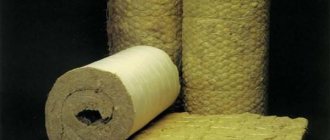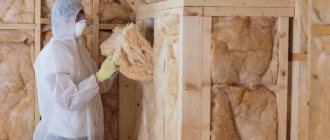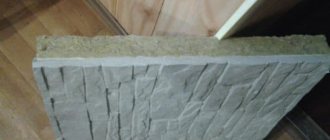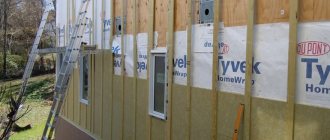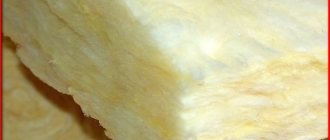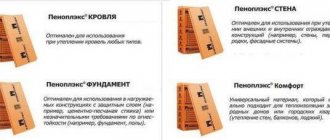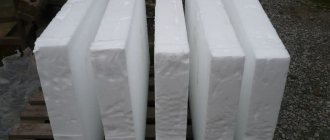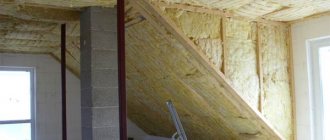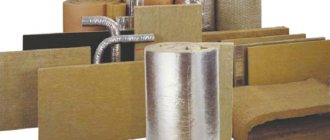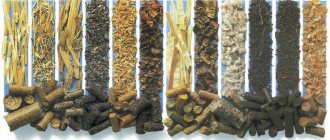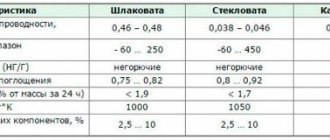Construction materials are always in high demand, so a business organized in this area will bring a constant and stable income. The production and sale of insulation is especially effective in a country with a climate that, to put it mildly, differs from the tropical one. How to open a mineral wool production plant in Russia and optimize your business to obtain maximum profits will be discussed in this article.
Stone mineral wool production technology
The production of mineral (basalt) wool involves melting rocks at a temperature of 1500 C. After which, the liquid lava-like mass is drawn into stone fibers using a centrifuge, special filters based on platinum or other heavy-melting metals and strong air currents.
Next, various water-repellent additives and plasticizers are added to the resulting fibers, after which, at a temperature of about 200 C, a polymerization process occurs, as a result of which equipment for the production of mineral wool produces ready-made basalt slabs, which are cut according to the required dimensions.
Pros and cons of mineral wool production
Before starting mineral wool production in Russia, you need to familiarize yourself with the main advantages and disadvantages of this type of business. Advantages of mineral wool production:
- Inexpensive raw materials.
- Fast payback.
- Minimum need to attract hired workers.
- Long shelf life of the produced material.
Disadvantages of mineral wool production:
- The price of equipment for mineral wool is at least 6 million rubles.
- High energy consumption during melting of raw materials.
- The need for properly equipped warehouses with a large area.
If there is a sufficient amount of financial resources, all of the listed shortcomings can be easily solved, and if it is possible to establish production near the source of raw materials, then the current costs of running this business will be reduced as much as possible.
Chemical composition of stone wool
Since the production of thermal insulation materials of this class is carried out exclusively from rocks, the resulting basalt fibers have the following chemical composition:
- Silicon dioxide SiO2 in an amount from 45 to 55%.
- Titanium dioxide TiO2 with a mass fraction from 1.36 to 2%.
- Calcium oxide CaO in an amount from 7 to 11%.
- Iron oxides FeO and Fe2O3 with a mass fraction from 5.38 to 13.5%.
- Manganese oxide MnO in the range of 0.25 to 0.5%.
- Aluminum oxide Al2O3 with a percentage of 14 to 20%.
- Manganese oxide MgO in an amount from 3 to 8%.
- Sodium and potassium oxide (Na2O, K2O) in amounts from 2.7 to 7.5%.
- Other substances make up no more than 5%.
All of the above oxides are bonded to each other using bitumen, synthetic or composite binders, or using bentonite clay.
The main indicator of the quality of the resulting basalt fiber is the acidity modulus, which depends on the ratio between acidic and basic (meadow) oxides. Its value is regulated in accordance with the requirements of GOST 4640-93 “MINERAL WOOL. Technical conditions".
According to the above document, stone wool is divided into 3 categories:
- Category “A” with an acidity modulus of 1.6 and above.
- Category “B” with an acidity modulus in the range from 1.4 to 1.6.
- Category “C” with acidity modulus below 1.4.
As can be seen from the above categories, the higher the acidity modulus, the higher quality the basalt wool is, since it is more durable and moisture resistant.
Very often, to regulate the above indicator, manufacturers use various additives based on carbonate compounds.
Conclusion
Stone wool is basalt mineral wool obtained by melting rocks, with the addition of binding components that are absolutely safe for human health and the environment, and its technical characteristics and positive reviews allow it to be used for insulating facades, vertical and horizontal elements of buildings and structures, floors, ceilings, wells, pipelines, roofing and other surfaces.
In the catalog of our online store you can buy any stone wool insulation in the section: Basalt wool, with delivery and unloading in St. Petersburg and the Leningrad region. For additional information on the terms of purchase, please contact your consultants.
Should I choose basalt insulation?
Types and scope of application of basalt fibers
Equipment for the production of mineral wool allows us to produce the following types of stone (basalt) fiber:
- Microfine fibers for the manufacture of fine filters for air or liquid media with fiber diameters less than 0.6 microns.
- Ultra-thin stone fibers are used in fine filters for air, gas or liquid media, or in the production of ultra-light sound and heat insulating materials with fiber diameters in the range from 0.6 to 1 micron.
- Superthin (microcrystalline) basalt fibers are used for the manufacture of heat and sound insulating waterproof products (mats or rolls), various bundles and filters. This type of fiber is considered the most popular because, thanks to special heat treatment, the resulting microcrystals are able to withstand temperatures 200 C higher than previous types of fibers. Also, super-thin microfiber (diameter from 1 to 3 microns) does not shrink during operation, which significantly increases the range of applications of this material.
- Thin mineral-based fibers are chaotic structures with fiber diameters ranging from 9 to 15 μm. The length of individual fibers ranges from 3 to 2000 mm. This material is widely used in coarse filters, as well as in the production of mineral insulation for industrial needs.
- Thickened stone fibers are most often used as the main filtration systems for drainage systems. The thickness of this type of fiber ranges from 15 to 25 microns, and the length from 5 to 1500 mm.
- Thick fibrous structures are chaotically arranged fibers with a diameter of 25 to 150 microns and a length of one fiber from 0.05 to 3 m. Thanks to this, the resulting material can withstand enormous tensile loads of up to 650 MPa.
- Coarse fibers are a dispersive fibrous mass of fibrous structures with a thickness of 150 to 500 microns. This type of insulation can be used as a reinforced layer using special binding elements.
Marketing and sales channels
The best marketing is honesty. Most people, given the alternative of choosing between a cheap and safe material, will prefer the second. Based on this, a large inscription on the packaging “ECO”, “environmentally friendly”, “eco-friendly” is good advertising.
For these words to be true, it is necessary to import raw materials from quarries that do not contain granite or radioactive shale rocks. And the manufacturing technology of mineral wool itself assumes resistance to fire and the release of toxic substances.
The main consumers of mineral wool are organizations specializing in suburban construction. It is necessary to rely on attracting them for ongoing cooperation.
One of the most effective advertising moves can be considered creating your own website. This will help in finding customers interested in purchasing large quantities of goods and long-term cooperation.
Scope of application of basalt (stone) wool
Due to the fact that stone wool is a natural, non-flammable and durable material (since it consists of 95% natural stone), it has been widely used in construction since the beginning of the 20th century.
Due to its excellent properties, which include reducing thermal energy losses during the cold period, and reducing the entry of thermal energy into the building in the summer, stone wool is widely used in the following areas:
- When insulating building facades followed by plastering or installing siding or profile sheets.
- When insulating a room from the inside (balconies, loggias, external walls, etc.).
- When constructing partitions from gypsum plasterboard sheets in apartments, industrial or office buildings for sound insulation.
- When insulating the base of the floor and then pouring the screed.
- For soundproofing floating floors.
- When installing roofing or insulating attic floors.
- For fire protection of engineering structures and networks (this material can withstand temperatures up to 700 C).
Cellulose insulation
This thermal insulation material is better known in our country as ecowool. This is a fairly effective insulation with low air tightness and thermal conductivity, and high sound absorption. There is no shrinkage or moisture. Consists of 81 percent prepared cellulose and 19 percent natural boron components (borates).
The advantage of this technology is that ordinary newsprint can be used as a raw material. Modern installations for the production of cellulose make it possible to process any type of waste paper, which indicates the economic benefits of the material. As a result, such insulation production in Russia is constantly increasing.
Advantages of stone wool (basalt insulation)
High chemical resistance. Thanks to this property, the material does not react with alkalis and acids and has increased resistance to petroleum products and solvents.
Porous structure. Due to this property, fibers make up only 70% of the total volume of the material. The rest are layers of air, which provide low thermal conductivity of the resulting material.
Fire resistance. This property makes it possible to insulate both steam pipelines and industrial equipment at high temperatures. Since the material is made from natural stone, it can withstand temperatures up to 7000C.
High vapor permeability. Thanks to this property, the material does not absorb, but rather allows moisture to pass through without the formation of condensation.
Equipment selection
Before you begin searching and selecting the equipment you will need, you need to clearly define and formulate the requirements for the selected equipment: minimum time for setup and preparation for work; stable power; performance adjustment; compactness; accuracy of dosing of raw materials and components; light weight; maintainability, easy replacement of worn mechanisms, etc.
Main manufacturers of stone wool
In the modern market, there are 3 main manufacturers of basalt-based mineral wool:
- TechnoNIKOL.
- Knauf.
- Rockwool.
Mineral wool TechnoNIKOL
This material is used for heat and sound insulation of facades, roofs, partitions and process pipelines. The density of this material ranges from 30 (ROCKLIGHT and TKHNOLIGHT Extra) to 145 kg/m3 (TECHNOFAS).
In the modern Russian market, this product is represented by the following varieties:
| Name | Nominal density, kg/m3 | Thermal characteristics, W/m*0С | Application area |
| ROCKLIGHT | 30 | 37-41*10-3 | Thermal insulation of walls and partitions indoors, insulation of pitched roofs and floors on joists |
| TECHNOLITE EXTRA | 35 | 36-41*10-3 | Installation of sound and heat insulation of partitions of office and domestic premises |
| TECHNOFAS | 145 | 36-42*10-3 | Insulation of facades before subsequent plastering or finishing with siding |
| TECHNOFLOOR | 90-170 | 34-47*10-3 | Insulation of floating, heated or self-leveling floors followed by installation of cement-sand screed |
| TECHNORUF | 140-190 | 36-42*10-3 | The main thermal insulation layer for new construction or reconstruction of roofing without the need for subsequent screed |
| TECHNOBLOCK STANDARD | 45 | 34-39*10-3 | Insulation and sound insulation of all types of buildings and structures in which the insulation layer is not subject to high static loads |
| TECHNOVENT STANDARD | 80-90 | 33-40*10-3 | Installation of ventilated facades |
Basalt wool Knauf
Knauf stone wool is an effective heat and sound insulation based on rocks, which has high vapor permeability and chemical resistance to acids, meadows and petroleum products.
On the Russian market, this material is produced under the Knauf Insulation brand and is represented by the following assortment:
| Name | Nominal density, kg/m3 | Thermal characteristics, W/m*0С | Application area |
| Insulation DDP | 150-200 | 40*10-3 | Insulation and sound insulation of a flat roof, the angle of inclination of which does not exceed 150 |
| Insulation DDP-K | 105-110 | 37-41*10-3 | Insulation and sound insulation of flat roofs, the angle of inclination of which does not exceed 150, as well as for insulation of floating floors |
| Insulation FKD | 140-150 | 39*10-3 | Insulation of external building facades or installation of ventilated facades |
| Insulation FKD-S | 100-140 | 36*10-3 | Insulation of external walls and construction of bonded facades |
| Insulation FKL | 85 | 40*10-3 | External wall insulation before siding installation |
| Insulation HTB | 35-150 | 37-39*10-3 | Insulation of utility networks, pipelines and air ducts with temperatures from -180 to 7000C |
| Insulation LMF AluR | 35-90 | 40*10-3 | Insulation of utility networks, pipelines and air ducts with temperatures from -180 to 7000C |
| Insulation PVT | 175 | 40*10-3 | Insulation of floors and floating floors |
| Insulation WM 640 GG/WM 660 GG | 80-100 | 35*10-3 | Insulation of process equipment and pipelines |
| Insulation cylinders | 75 | 40*10-3 | Technical insulation of utility networks and pipelines |
Rockwool basalt wool
Rockwool's products are highly efficient hydrophobized mineral slabs made from basalt rock with the addition of special additives to improve technical characteristics.
The company offers the following range in Russia:
| Name | Nominal density, kg/m3 | Thermal characteristics, W/m*0С | Application area |
| EPIROCK | 20 | 45*10-3 | Insulation of ventilated floors, as well as wooden floors on joists |
| ROCKROLL | 22 | 44*10-3 | Insulation of ventilated floors, as well as wooden floors on joists |
| ROCKSLAB ACUSTIC | 50 | 36*10-3 | Soundproofing of ceilings and partitions of premises for various purposes |
| ROCKSLAB | 26 | 42*10-3 | Insulation of walls, ceilings and floors without loading the stone wool layer |
| STEPROCK HD | 140 | 39*10-3 | Insulation of building structures and floors with high dynamic loads |
| ROCKMIN | 26 | 39*10-3 | Construction of a non-loaded thermal insulation layer |
| STEPROCK HD4F | 140 | 39*10-3 | Device of dynamic modulus of elasticity for industrial and residential buildings |
| FRONTROCK S | 110 | 39*10-3 | Insulation of facades of buildings and structures with subsequent application of a reinforced layer and plaster |
| MONROCK MAX E | 115-220 | 37*10-3 | Insulation of all types of floors without the need for subsequent installation of cement-sand screed |
| FIREROCK | 80 | 42*10-3 | Thermal insulation of the surface of fireplaces and technological equipment |
conclusions
Equipment for the production of mineral wool allows us to produce highly effective insulation for any type of premises, as well as provide reliable heat and sound insulation of both the roof, floors and walls.
On the modern market you can find a wide variety of mineral insulation materials based on basalt rocks, which not only have high technical characteristics, but also provide fire resistance to process pipelines in accordance with international standards.
Business relevance
Considering the desire of city dwellers to leave dusty metropolises even for weekends and vacations, we can predict the demand for the construction of country houses. Mineral wool is used to insulate the walls of buildings internally and externally. It is also used as insulation for floors, roofs, and ceiling partitions between the living space and the attic. If there is a concrete, waterproofed basement, it is also insulated with mineral wool.
Semi-rigid mineral wool is an excellent noise absorber, which in practice is used for interior cladding. In wooden buildings with home boiler rooms, certain types of mineral wool protect the wood from overheating, which is one of the fire safety requirements. It is also used for internal wall insulation in rooms with stoves and fireplaces. This natural material is also used in chimney insulation and insulation.
As long as there is demand for the construction of private wooden, brick, block, and panel houses, the demand for insulation materials will grow. And man’s desire to be closer to nature is not questioned. In order to organically fit into a segment in which other manufacturers have been operating for a long time, it is necessary to correctly select the type of wool that is most in demand in the region.
Types of mineral insulation
Glass, slag, basalt are the main ingredients of insulation materials, united under the common name “mineral wool”. It is the main component that influences the area in which the insulation will be used.
Glass wool is an extremely unpleasant material for insulating residential premises. Brittle fibers formed from molten glass cause severe irritation to the skin, respiratory tract, and mucous membranes. Despite the lowest density among all types of mineral wool, fiberglass is not advisable to use to protect housing due to its high hygroscopicity and relatively low melting point. Melting of this material occurs at t – 300° C.
- release form - roll;
- yellow color;
- scope of application – insulation of pipelines and technical premises.
When using fiberglass material for insulation, it itself needs protection from getting wet, otherwise it will cease to perform its functions.
Stone wool has the lowest thermal conductivity, weakly absorbs moisture, and allows steam to pass through. This is the most popular type of mineral wool insulation in construction. The structure of isolated cells is the best barrier to sounds from the outside.
The consumer will receive a material with two important characteristics for insulation, and the manufacturer will significantly save on the consumption of binders during production. This is necessary so that marketers can justifiably assign the title ECO-cotton wool to this material.
To insulate the interior of a house, the material must meet certain requirements for the release of toxins when heated or burned, which limits the use of binders. Regardless of the presence of the ECO prefix on the packaging or in the name of the insulation, only such (safe for human health) mineral wool meets the sanitary requirements for internal insulation of houses.
The cheapest cotton wool for insulating outbuildings is made from slag. It is not suitable for interior work in residential areas due to the insufficient strength of the fibers and their low resistance to high temperatures. When insulating communication pipes, this material is not used in the heating network.
What is the density of mineral wool influenced by?
The density of the cotton filler is measured in kg/m3. Stone wool density indicators vary from 20 to 220 kg/m3. These numbers indicate the degree of rigidity, the weight of a cubic meter of material, and resistance to vertical loads. Cotton wool with a density of 220 kg/m 3 can withstand loads of up to 700 -750 kg per m 2.
